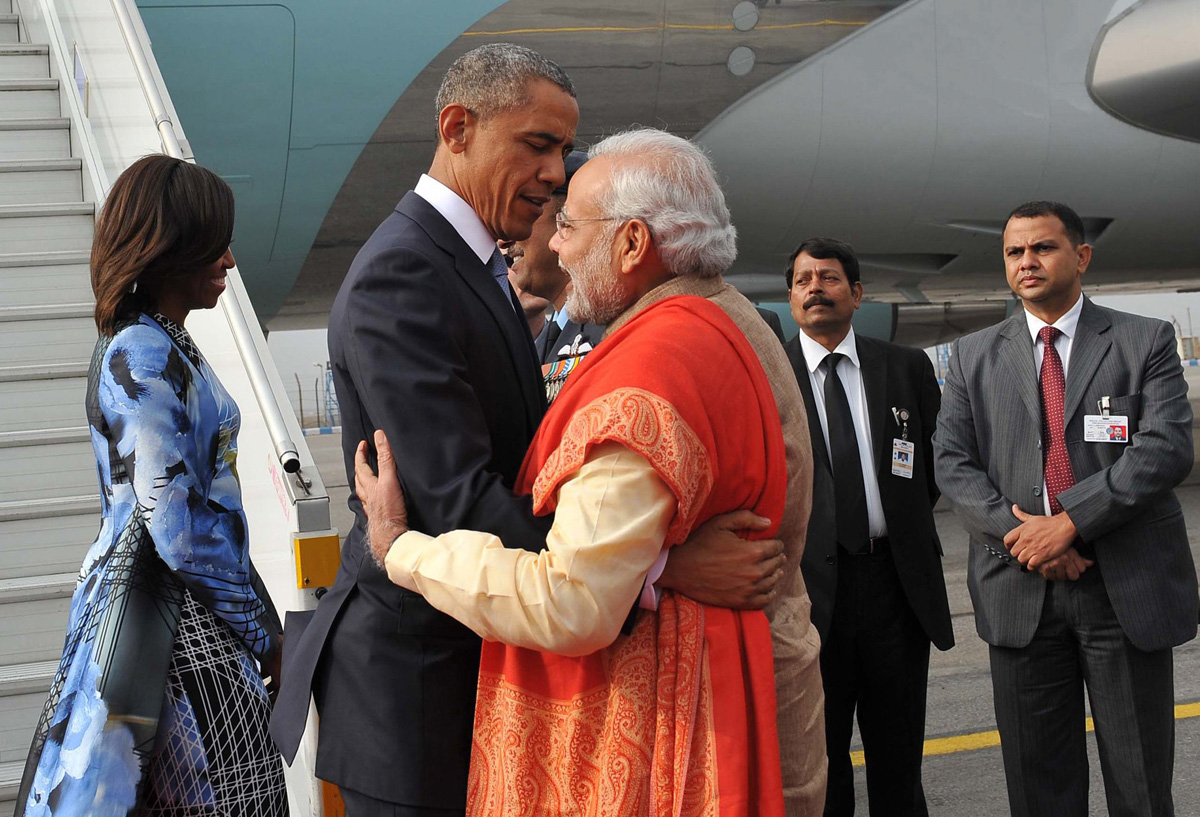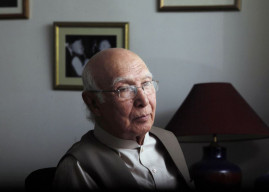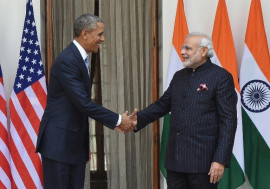
The American pivot towards the Pacific is coincident with both China and India advancing economically and militarily, and America as it pivots, does not want to lose sight or contact with a country that is becoming a key regional power and a counter-weight to the influence exerted by China. The rehabilitation of Mr Modi is driven by a cynical pragmatism, and had he not looked to be on course to win the 2014 Indian general elections, he would still be out in the cold — but win he did, and Indo-American relations had to be rebooted. President Obama’s visit to India is truncated by the necessity of visiting Saudi Arabia to condole the death of King Abdullah, but truncated or not, it was highly symbolic. President Obama not visiting Pakistan whilst in the neighbourhood is no less symbolic. There has been a warming of relations between Pakistan and the US in the last six months, but nothing like the extent to which relations between India and the US have come out of the freezer. America will be watching our reaction to the Obama visit, and it is impossible to believe that Pakistan did not feature on the agenda somewhere in it, but cynical pragmatism is yet to be deployed in our direction.
Published in The Express Tribune, January 27th, 2015.
Like Opinion & Editorial on Facebook, follow @ETOpEd on Twitter to receive all updates on all our daily pieces.
COMMENTS (13)
Comments are moderated and generally will be posted if they are on-topic and not abusive.
For more information, please see our Comments FAQ




































Wrong. The mere fact that USA has kept up a dialogue/relations with Pakistan after the discovery of OBL outside the wall of Pakistan Military Academy is ample evidence that USA pragmatism is at work. Pragmatism also means that the USA is no longer going to try and create the facade that Pakistan and India have to be treated as equals.
The world has quickly woken up to the fact that new PM Modi has come to Power with an absolute majority, has a vision, knows what needs to be done and in a position to deliver. The India of "chalta hai" attitude is past tense. Who will not respect a man who is so driven he sleeps just three hours a day yet has energy to work over sixteen hours a day. PM Modi understands that the world respects strength, shuns ambiguity and welcomes collaboration where everyone profits. IF India and the US can can even carry forward on half the agenda agreed upon in this visit, India could stand transformed and American economy rejuvenated by being a major participant in the last great Investment opportunity, not seen since China's rise. The key areas of collaboration agreed on are :- 1] Infrastructure development. 2] Transport infrastructure. 3] Nuclear energy & Non Conventional Energy. 4] River linking & Water Management. 5] Joint Research, Development and Manufacture of next generation Weapon systems.
Most of the large economies of the world have aging population, for India the demographic dividend from a young population could propel it to the top if attention is focused on Education, skill development and retraining. India is currently producing so many high quality Engineers and Scientists, most of the new Technological developments in the second half of this century could have Indian origins. I think Indians today realize that the world is looking to them to make greater contributions in every field, here on India will be unlikely to disappoint them.
Toticalling:
This is a common misconception lot of people have.
China will overtake US economy in 30years in GDP terms, if it doesn't get a huge uprising first. But, what one forgets is - China's biggest markets are USA & Europe, who are unlikely to sit still and let China walk away with their markets. They will find alternatives, and it will create unrest in China (which needs high growth to keep dissenters quite).
And even if China achieves #1 position in GDP terms, in percapita terms it will remain a light weight. i.e. It will have lesser percapita than even countries like Malaysia. You may wonder how this impacts a country's capability?
Here is how - India has higher GDP today than Japan (PPP terms), but it matters little, because it can't invest as much as Japan in R&D, technology, Education and security. Thus, Japan will continue to be a premier power.
USA can afford to spend so high on it's defence (it outspends the next 10 countries!!), because it has high per capita, thus has very high tax revenues. China/India can not match that in a 100 years.
Thus both China and India can overtake USA as largest economy, but not as a technology & military super-power.
The Editorial has missed the significance of the Finalization of the Indo US nuclear deal. +++++++++++++++++++++++++++++++++++++++++++++++++++ which is the proof of the pudding. While Pakistan's focus is US Dollars for IDPs...India's focus is superpower status.
Sack the Security Adviser and the Paki ambassador to Washington.... ++++++++++++++++++++++++++++++++++++ they hv failed no doubt.
What both Obama and Modi share is a sense of knowing what it takes to come up from unfortunate circumstances and to succeed inspite of all odds. As they say bonds are built on trust, and it is easier to trust when you know the other person's struggles.
Besides, US also understands how stupid it was to have denied Modi a visa for a long long time, and how it nearly backfired on it.
And the most important thing of all - India needs USA and USA needs India. Not for security, but for technology co-operation. India has the biggest pool of English educated, scientific man power in the world, something that attracts a technological nation like USA. And India lacks the cutting edge technology to make the leap forward.
These confluence of interests, along with steadfast commitment to democracy make US-India natural allies, even if it is not stated in as many words/treaties.
Pakistan relation to both US and China is based on tactical nature not natural. With US every step is based on terrorism. With China is based on India.
To repeat the cliche, nothing is permanent other than national interest. When is Pakistani establishment going to realize that 'you cannot fool all the people all the time'. You really do not have any friends now. Any bomb blasts in China traced to Pakistan, you guys are toast. Double game days are over. Deal with the extremists and try to uplift the lives of common people instead of trying to push the terrorists amid cross border firing. .
Once upon a time USA was a good friend. Those were the good old days. WE know that friendship of nations is related to self interst and not love or liking. Here India has better cards to offer than Pakistan. But do not worry, this warmth can cool down if and when international scene changes. Pakistan has advantages due to approximity with Afghanistan and China. And America is not the tiger of yesteryears. China is still close with Pakistan and it will overtake USA in next 30 years in political and military power. It already has more surplus money than any other nation.
Actually, cynical pragmatism was being shown towards Pakistan for a "very" long time..going back to falsely certifying that Pakistan was not pursuing a bomb, knowing fully well that it is.
"America will be watching our reaction to the Obama visit, and it is impossible to believe that Pakistan did not feature on the agenda somewhere in it, but cynical pragmatism is yet to be deployed in our direction."
I don't think America cares about Pakistan's reaction. If it did, Obama would have included a Pakistan visit in this trip.
As for "cynical pragmatism" in Pakistan's direction, does the editor forget the attention the US has been paying (both in dollar terms and in political capital) to Pakistan for the past decade and more. The "cynical pragmatism" was based solely on Pakistan being a global nuisance/migraine with respect to terrorism and nuclear proliferation
The trouble with this article is that it underestimates Obama's intelligence. Obama is the first President the United States has ever had that understood Pakistan right from the start of his Presidency. This clip from Obama campaign in 2007-2008 illustrates how well he understood Pakistan.
Obama Was Right About Pakistan
https://www.youtube.com/watch?v=WbauMlBWo6s
Normally it takes US presidents at least 2 terms before they understand Pakistan. Obama's treatment of Pakistan reflects his understanding.
It would be a mistake to view the Indo-US relationship simply in terms of geo-politics since a significant part of it has to do with growing trade and economic interaction. In the coming years, growth in India is projected to exceed that of China and this has much to do with the warming relations. Renewable energy, diasporic bonds and democratic traditions also have much to contribute to the growing bond.
Secondly, all geo-politics is based on "cynical pragmatism". Such pragmatism is behind the friendships of the moment and not any of the touchy-feely sweeter than honey stuff.